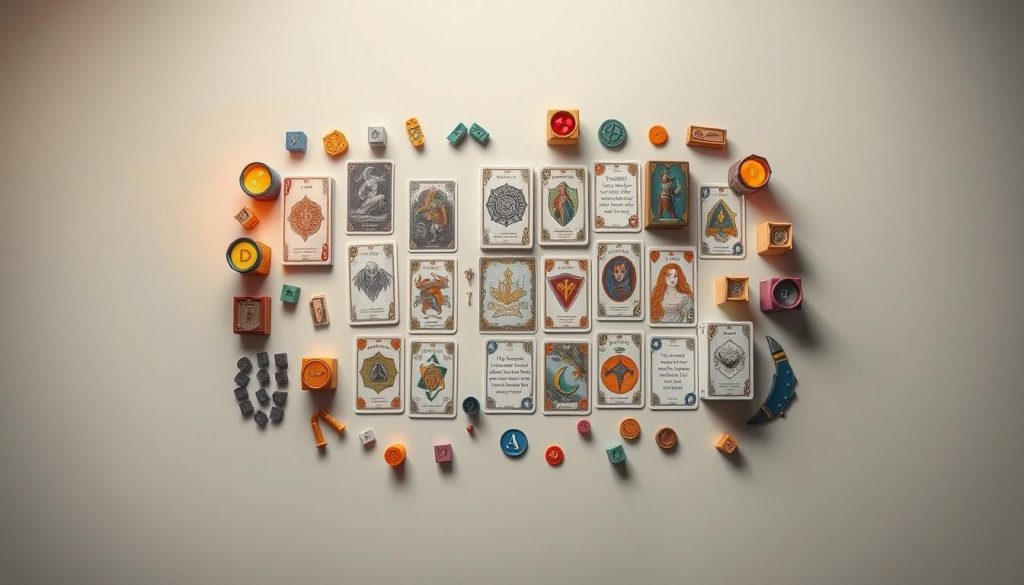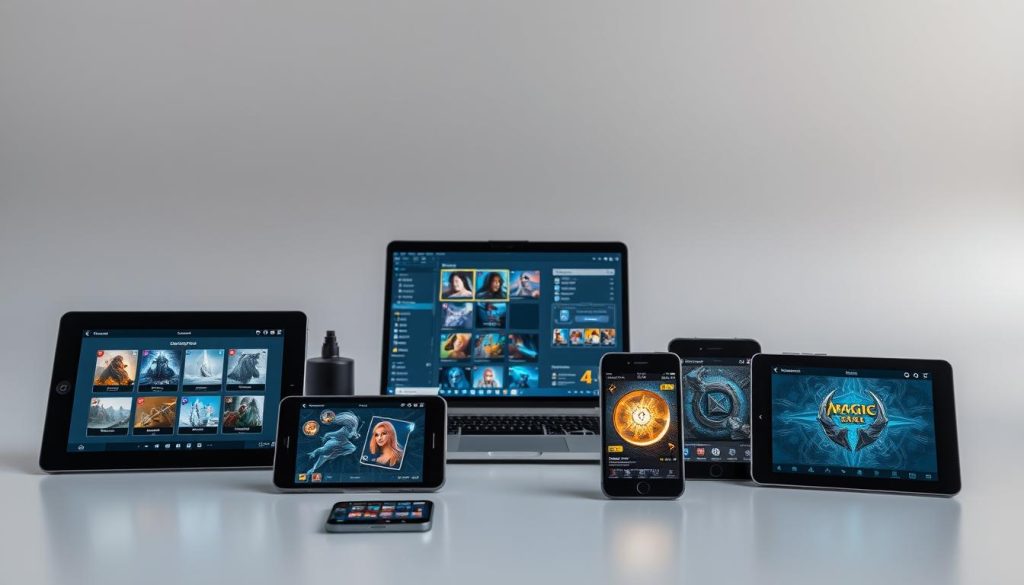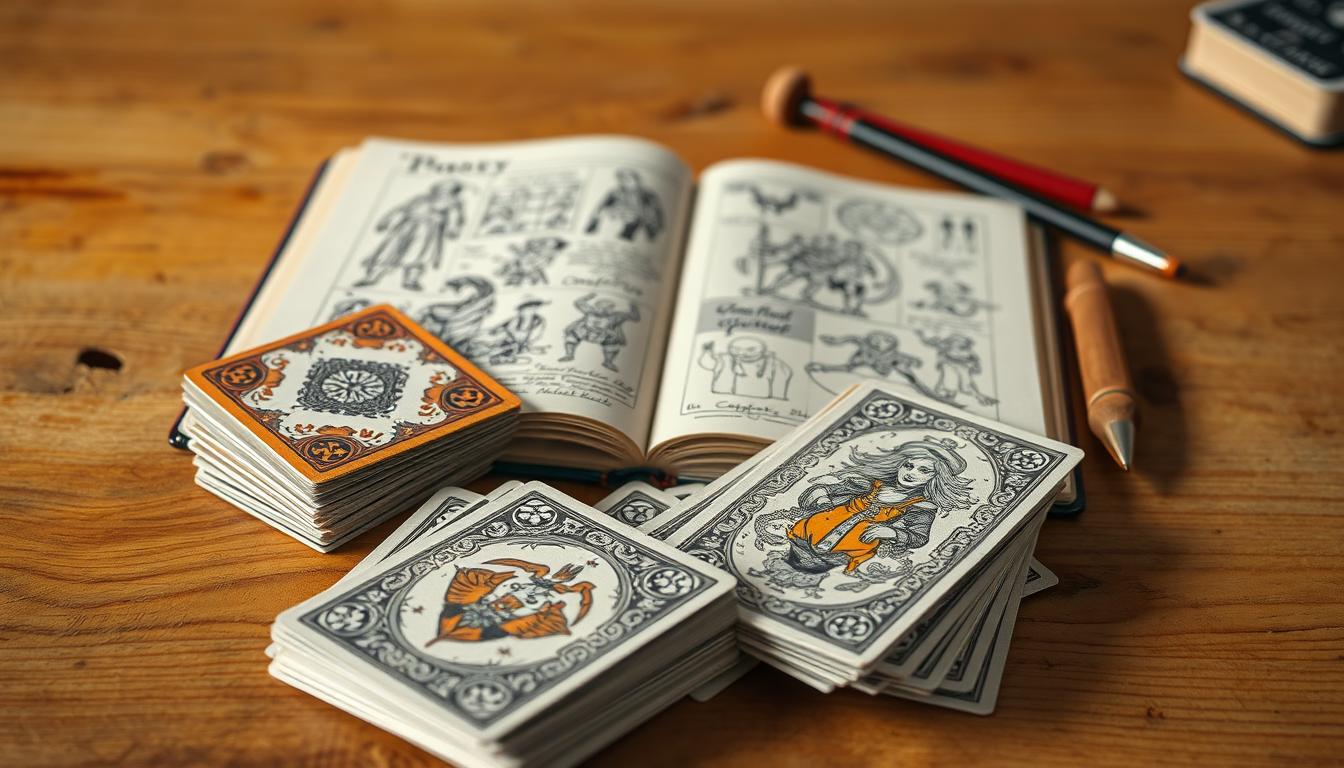Imagine making your game ideas real. Creating a card game is more than a hobby. It’s a fun journey of creativity and self-expression.
If you love board games or want a new challenge, try making a DIY card game. It’s a great way to share your unique ideas with the world.
Designing your card game lets you play with game mechanics and stories. You can create anything from fantasy worlds to complex strategy games. Your only limit is your imagination.
Game designers like Eric Lang and Rob Daviau started with a passion for something new. They show that anyone can create something original.
This guide will help you make your own card game. We’ll cover everything from the first idea to the final product. You’ll learn how to make a simple party game or a complex strategy game.
Are you ready to start your DIY card game adventure? Your game is waiting to be created. Let’s begin!
Why Making Your Own Card Game Is the Ultimate Creative Project
Starting a custom card game opens a world of fun for creative people. It mixes art with strategy, turning a hobby into a learning journey.
Creating a card game is more than just making rules. It’s a deep dive into creativity, teaching you important skills and letting your imagination soar.
Unleashing Personal Creativity
When you design your own card game, you naturally learn game development skills. You get to:
- Craft unique game stories
- Design cool game mechanics
- Make interesting characters
- Try out different looks
Learning Opportunities in Game Design
Card games offer more than just fun. You’ll learn skills like:
- How to solve problems strategically
- Creating complex rules
- Thinking critically
- Managing projects
By diving into this project, you change how you see game design. It turns your passion into a valuable skill.
Essential Materials and Tools for Card Game Design

Creating your own card game needs careful picking of materials and tools. It doesn’t matter if you’re new or have experience. The right tools can make your idea come to life.
First, get the basic materials for your card game:
- High-quality cardstock (minimum 250 GSM weight)
- Sharp craft scissors or paper trimmer
- Precision ruler and cutting mat
- Protective card sleeves
- Pencils and erasers for initial sketching
Digital tools for card game design are getting better. Experts suggest using certain software to help you create:
- Adobe Photoshop for advanced graphic design
- Canva for easy card templates
- GIMP (free alternative to Photoshop)
- Tabletop Simulator for digital prototyping
Choose materials that last and look good. Go for top-notch supplies that can handle many games. You can find great stuff at local craft stores and online.
If you’re watching your budget, start simple and get better supplies later. The most important thing is to have fun making your card game.
Create Your Own Card Game: Getting Started With Basic Rules
Creating a card game needs careful planning and creativity. Game designers must balance rules and fun game mechanics. The key to a great card game is its design basics.
- Identify the primary objective of your card game
- Determine player interactions and card interactions
- Create clear and concise rules that are easy to understand
- Design a logical flow of gameplay
Defining Your Game’s Core Mechanics
When setting up game mechanics, aim for something unique. Think about how players will use cards and what strategies they might use. You want a system that’s easy to learn but still challenging.
Balancing Game Elements
Keeping the game balanced is key to keeping players interested. Make sure the scoring system is fair and no one strategy can win all the time. Try out different card combinations and tweak their strengths and weaknesses for a fun game.
Testing Your Initial Concept
Playtest your card game a lot. Get feedback from friends, family, or local game groups. Be ready to make changes based on what you learn. Each test gives you ideas for making your game better.
- Create multiple prototype versions
- Observe player interactions
- Collect and analyze feedback
- Refine game design based on playtesting results
Designing Eye-Catching Card Layouts and Templates

Creating a card game layout is like art. It mixes creativity with practical design. Good visual card design pulls players into your game world. It makes them feel like they’re part of it.
When making your card game layout, keep these tips in mind:
- Use color psychology to evoke emotions and guide player attention
- Select typography that enhances readability and matches your game’s theme
- Create consistent visual hierarchy across all card designs
- Balance graphic elements with clear information zones
Digital design tools are great for making card design templates. Adobe Illustrator and Canva are popular choices. They have easy-to-use interfaces for game designers. If you like drawing, start with sketches on grid paper. This helps keep your designs even and aligned.
Your card game layout should tell a story quickly. Use visuals that show your game’s main ideas and theme. Try out different colors, icons, and styles to make your cards stand out.
- Keep text readable with clear font choices
- Use white space effectively to prevent visual clutter
- Match design elements to your game’s overall aesthetic
Remember, amazing visual card design turns simple game parts into exciting adventures. Players will love diving into your game.
Crafting Engaging Characters and Artwork for Your Cards
Designing card game characters is like painting a picture. It brings your game’s world to life. Your card artwork is like a secret language that pulls players into your world.
When making card game characters, aim for ones that stick in your mind. They should match your game’s theme. Good character design tells a story and makes players feel a connection to the game.
Character Development Guidelines
- Create characters with clear motivations and backstories
- Develop unique visual traits that distinguish each character
- Ensure characters align with your game’s overall narrative
- Balance character abilities and strengths
Art Style Selection
Choosing the right art style is key for card artwork. It should match your game’s feel and look. You might like realistic, comic-book, or simple designs. But, keep it consistent for character design.
Visual Hierarchy Tips
- Prioritize important information on each card
- Use color and contrast to guide player attention
- Create clear visual zones for stats and descriptions
- Maintain readable typography
Great card game characters and artwork make a game feel real. Spend time on visual details that grab your players’ attention.
Digital Tools and Software for Card Game Creation

Creating a card game is now easier than ever. Many digital tools are available today. These tools help designers turn their ideas into professional-looking prototypes fast.
Several powerful digital game creation apps are great for aspiring game designers:
- Tabletop Simulator – A versatile platform for digital card game prototyping
- Photoshop – Professional graphic design software for creating stunning card artwork
- Tabletopia – Online game design tool for collaborative card game development
- Canva – User-friendly design app with templates for card layouts
Choosing the right tools depends on your skill level and project needs. Beginners might like Canva’s easy interface. Experienced designers might prefer Adobe Creative Suite’s advanced features.
Most card game software has important features like:
- Drag-and-drop card creation interfaces
- Professional template libraries
- Collaborative design capabilities
- Export options for printing and digital sharing
Whether you’re a hobbyist or a pro, modern tools make card game creation fun and accessible. Try out different apps to find the best one for your design.
Printing and Production Methods for Your Custom Cards
Turning your card game design into real cards needs careful thought. You have to pick the right printing and production methods. Whether you want top-notch results or something more affordable, knowing your options is key.
Professional printing services have big benefits for game makers. They offer quality that makes your game look and feel better.
Professional Printing Options
- Research specialized game card printing companies
- Compare pricing and minimum order quantities
- Request sample prints to assess card quality
- Check paper stock and finish options
DIY Printing Solutions
If you’re on a tight budget or like to do things yourself, DIY card making is a good choice. It’s great for making prototypes or small games.
- Use high-quality cardstock paper
- Invest in a reliable color printer
- Consider lamination for increased durability
- Test different paper weights and finishes
Card Quality Considerations
The materials you choose greatly affect your game’s look. Quality means thickness, finish, and how clear the print is. Experts say to pick materials that last and play smoothly.
Try out different printing ways and materials. Find the best mix of cost, durability, and looks for your card game.
Playtesting Strategies and Gathering Feedback
Card game playtesting is key to making your game better. It helps find what works well and what needs work. This is important because it’s not always clear during the first try.
Getting good feedback is all about planning. First, find a group of people with different skills and interests. This way, you get a wide range of opinions on your game.
- Invite friends, family, and local board game enthusiasts
- Use online gaming communities for broader feedback
- Consider game design forums and local gaming groups
When you test your game, watch how people play. Note their reactions and what they like or dislike. Make sure they feel safe sharing their thoughts.
Improving your game means looking at the feedback closely. Make a plan to organize and understand what players say. Look for common themes and make small changes to make the game better.
- Document player comments and suggestions
- Track specific moments of confusion or engagement
- Prioritize feedback that improves game balance and fun
Playtesting is not a one-time thing. It’s a journey to make a game that people will enjoy. With each test, you get closer to your goal.
Marketing and Sharing Your Finished Card Game
Creating a card game is exciting. But sharing it with the world is where the real fun starts. Good card game marketing can turn your project into a hit game. It will attract players and build a loyal community.
Your game’s success depends on smart online promotion. This connects you with people who might play your game. The internet has many places to show off your game.
Building Your Game’s Community
Building a game community starts with the right strategies:
- Create dedicated social media accounts for your card game
- Join board game forums and discussion groups
- Share behind-the-scenes development stories
- Participate in local gaming events and conventions
Online Platforms for Game Promotion
Use online channels to make your game more visible:
- Kickstarter for crowdfunding support
- Board Game Geek for tabletop game enthusiasts
- Print-on-demand services like The Game Crafter
- Reddit board game communities
- Discord gaming servers
Good card game marketing is about connecting with players who love your game. Be real, stay active, and watch your community grow!
Legal Considerations and Copyright Protection
Understanding game design law can seem hard. But knowing about intellectual property protection is key for creators. Game copyright helps keep your unique card game safe from being copied or used without permission.
When making your card game, protect special things like artwork and card text. Game rules can’t be copyrighted, but how you express them can. Register your game’s artwork and written content with the U.S. Copyright Office for strong legal protection.
Game publishing laws also mean watching out for trademark issues. Make sure your game’s name and logo don’t clash with others. If your game uses licensed characters, get the right permissions to avoid legal trouble.
Professional game designers say to keep records of your game’s making. These records can help prove your game’s originality if needed. Protecting your work is crucial to turn your card game into something you can sell.

